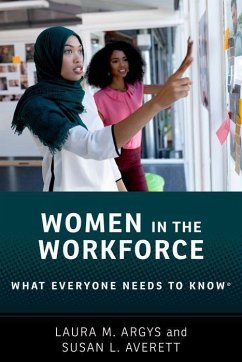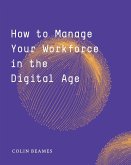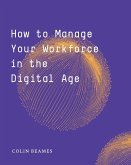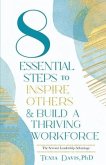20,99 €
inkl. MwSt.
Versandfertig in 2-4 Wochen

10 °P sammeln
- Broschiertes Buch
- Merkliste
- Auf die Merkliste
- Bewerten Bewerten
- Teilen
- Produkt teilen
- Produkterinnerung
- Produkterinnerung
Women in the Workforce: What Everyone Needs to Know ® provides an essential and accessible introduction to the significance of women in the economy and the obstacles they face in claiming equal status. Economists Laura M. Argys and Susan L. Averett tackle timely topics like the wage gap, "women's work," and gendered workplace interactions in an easy-to-read question and answer format.
Andere Kunden interessierten sich auch für
![Generation Virtual: The Next Generation Workforce & Workforce Virtualization Implications On Environment, Society, and Enterprises Generation Virtual: The Next Generation Workforce & Workforce Virtualization Implications On Environment, Society, and Enterprises]() Faisal ShehabGeneration Virtual: The Next Generation Workforce & Workforce Virtualization Implications On Environment, Society, and Enterprises22,99 €
Faisal ShehabGeneration Virtual: The Next Generation Workforce & Workforce Virtualization Implications On Environment, Society, and Enterprises22,99 €![How to Manage Your Workforce in the Digital Age How to Manage Your Workforce in the Digital Age]() Colin BeamesHow to Manage Your Workforce in the Digital Age28,99 €
Colin BeamesHow to Manage Your Workforce in the Digital Age28,99 €![How to Manage Your Workforce in the Digital Age How to Manage Your Workforce in the Digital Age]() Colin BeamesHow to Manage Your Workforce in the Digital Age28,99 €
Colin BeamesHow to Manage Your Workforce in the Digital Age28,99 €![8 Essential Steps to Inspire Others & Build a Thriving Workforce 8 Essential Steps to Inspire Others & Build a Thriving Workforce]() Tenia Davis8 Essential Steps to Inspire Others & Build a Thriving Workforce18,99 €
Tenia Davis8 Essential Steps to Inspire Others & Build a Thriving Workforce18,99 €![The New Urban Immigrant Workforce The New Urban Immigrant Workforce]() Sarumathi JayaramanThe New Urban Immigrant Workforce64,99 €
Sarumathi JayaramanThe New Urban Immigrant Workforce64,99 €![New Policies for the Part-time and Contingent Workforce New Policies for the Part-time and Contingent Workforce]() Virginia L. DurivageNew Policies for the Part-time and Contingent Workforce44,99 €
Virginia L. DurivageNew Policies for the Part-time and Contingent Workforce44,99 €![The Insecure Workforce The Insecure Workforce]() Edmund Heery / John Salmon (eds.)The Insecure Workforce80,99 €
Edmund Heery / John Salmon (eds.)The Insecure Workforce80,99 €-
-
-
Women in the Workforce: What Everyone Needs to Know ® provides an essential and accessible introduction to the significance of women in the economy and the obstacles they face in claiming equal status. Economists Laura M. Argys and Susan L. Averett tackle timely topics like the wage gap, "women's work," and gendered workplace interactions in an easy-to-read question and answer format.
Hinweis: Dieser Artikel kann nur an eine deutsche Lieferadresse ausgeliefert werden.
Hinweis: Dieser Artikel kann nur an eine deutsche Lieferadresse ausgeliefert werden.
Produktdetails
- Produktdetails
- Verlag: Hurst & Co.
- Seitenzahl: 256
- Erscheinungstermin: 1. März 2022
- Englisch
- Abmessung: 213mm x 140mm x 23mm
- Gewicht: 272g
- ISBN-13: 9780190093389
- ISBN-10: 0190093382
- Artikelnr.: 62580719
- Herstellerkennzeichnung
- Libri GmbH
- Europaallee 1
- 36244 Bad Hersfeld
- gpsr@libri.de
- Verlag: Hurst & Co.
- Seitenzahl: 256
- Erscheinungstermin: 1. März 2022
- Englisch
- Abmessung: 213mm x 140mm x 23mm
- Gewicht: 272g
- ISBN-13: 9780190093389
- ISBN-10: 0190093382
- Artikelnr.: 62580719
- Herstellerkennzeichnung
- Libri GmbH
- Europaallee 1
- 36244 Bad Hersfeld
- gpsr@libri.de
Laura M. Argys is Professor of Economics at University of Colorado Denver. Susan L. Averett is Professor of Economics at Lafayette College. They are co-editors, along with Saul Hoffman, of The Oxford Handbook of of Women and the Economy.
* Preface
* Introduction
* Chapter 1. ARE WOMEN AN IMPORTANT PART OF THE ECONOMY?
* a. How has women's attachment to the labor force changed over time?
* b. How does labor force participation vary across countries?
* c. Do women work as much as men?
* d. Do women take jobs from men?
* e. Does women's work count?
* f. How much do women contribute to the economy?
* g. How do recessions affect women?
* h. Is women's work different in developing countries?
* i. Do women influence spending decisions?
* j. Is there a pink tax?
* Chapter 2. IS THERE SUCH A THING AS WOMEN'S WORK?
* a. How do economists view the evolution of gender roles?
* b. When was it acceptable for women to work outside the home?
* c. How did women progress from jobs to careers?
* d. What jobs do women perform and how has that evolved over time?
* e. How are gender differences in occupation related to women's family
responsibilities?
* f. Was WWII really a watershed for women's work lives?
* g. How did birth control and abortion affect women's work and family
trade-offs?
* Chapter 3. HOW DO WOMEN BALANCE WORK AND FAMILY?
* a. What is the gender division of labor within a household?
* b. How do couples decide who does what?
* c. Is the division of labor different for same-sex couples?
* d. How did technology change the work women do?
* e. How is the timing of births related to a woman's career?
* f. Can women successfully combine breastfeeding and work?
* g. How does women's work behavior reflect family responsibilities?
* h. When does the caring end? Women in the sandwich generation.
* i. How do employers and the government help with work-life balance?
* Chapter 4. HOW DO MEN AND WOMEN INTERACT IN THE WORKPLACE?
* a. Have women made inroads in business leadership?
* b. Why are women underrepresented in the top business echelons?
* c. Are there differences in how women and men network and does it
matter for career success?
* d. Does working for a female manager enhance women's careers?
* e. Do women need mentors and if so, does it matter who they are?
* f. How does having female representation on boards of directors help
women?
* g. Why aren't women always heard in the workplace?
* h. Is there a gender gap in self-promotion? Does it matter?
* i. How does sexual harassment (and the #MeToo movement) affect women
in the workplace?
* Chapter 5. WHY ARE WAGES HIGHER ON MARS THAN ON VENUS?
* a. How are wages determined?
* b. How do we measure the gender pay gap?
* c. How big is the gender pay gap? Does it vary for women of color?
For immigrants? By sexual orientation?
* e. How does the pay gap vary across countries?
* f. What can we measure that might explain the reasons for gender pay
differences?
* g. What is left to explain the pay gap?
* Chapter 6. DO WOMEN EARN LESS BECAUSE MEN RULE THE WORLD?
* a. What exactly is labor market discrimination?
* b. What causes pay discrimination?
* c. Why is it so hard to measure discrimination?
* d. How do we measure discrimination?
* Chapter 7. CAN'T THE GOVERNMENT JUST FIX THE PAY GAP?
* a. What are the consequences of discrimination for the economy?
* b. How can we justify the existence of anti-discrimination laws?
* c. What laws protect women from discrimination?
* d. Who enforces these laws and how are they enforced?
* e. How effective are these laws?
* f. What might the future hold with respect to closing the gender pay
gap?
* Chapter 8. HOW DO WOMEN FARE IN RETIREMENT?
* a. How do people decide when to retire?
* b. How long is retirement for men and women?
* c. Where does retirement income come from?
* d. How much income do people have when they retire? How does this
vary by gender and race/ethnicity?
* e. Are women destined to be poor as they age?
* f. How do single women fare later in life?
* g. What options have been suggested to increase retirement security
for women?
* Introduction
* Chapter 1. ARE WOMEN AN IMPORTANT PART OF THE ECONOMY?
* a. How has women's attachment to the labor force changed over time?
* b. How does labor force participation vary across countries?
* c. Do women work as much as men?
* d. Do women take jobs from men?
* e. Does women's work count?
* f. How much do women contribute to the economy?
* g. How do recessions affect women?
* h. Is women's work different in developing countries?
* i. Do women influence spending decisions?
* j. Is there a pink tax?
* Chapter 2. IS THERE SUCH A THING AS WOMEN'S WORK?
* a. How do economists view the evolution of gender roles?
* b. When was it acceptable for women to work outside the home?
* c. How did women progress from jobs to careers?
* d. What jobs do women perform and how has that evolved over time?
* e. How are gender differences in occupation related to women's family
responsibilities?
* f. Was WWII really a watershed for women's work lives?
* g. How did birth control and abortion affect women's work and family
trade-offs?
* Chapter 3. HOW DO WOMEN BALANCE WORK AND FAMILY?
* a. What is the gender division of labor within a household?
* b. How do couples decide who does what?
* c. Is the division of labor different for same-sex couples?
* d. How did technology change the work women do?
* e. How is the timing of births related to a woman's career?
* f. Can women successfully combine breastfeeding and work?
* g. How does women's work behavior reflect family responsibilities?
* h. When does the caring end? Women in the sandwich generation.
* i. How do employers and the government help with work-life balance?
* Chapter 4. HOW DO MEN AND WOMEN INTERACT IN THE WORKPLACE?
* a. Have women made inroads in business leadership?
* b. Why are women underrepresented in the top business echelons?
* c. Are there differences in how women and men network and does it
matter for career success?
* d. Does working for a female manager enhance women's careers?
* e. Do women need mentors and if so, does it matter who they are?
* f. How does having female representation on boards of directors help
women?
* g. Why aren't women always heard in the workplace?
* h. Is there a gender gap in self-promotion? Does it matter?
* i. How does sexual harassment (and the #MeToo movement) affect women
in the workplace?
* Chapter 5. WHY ARE WAGES HIGHER ON MARS THAN ON VENUS?
* a. How are wages determined?
* b. How do we measure the gender pay gap?
* c. How big is the gender pay gap? Does it vary for women of color?
For immigrants? By sexual orientation?
* e. How does the pay gap vary across countries?
* f. What can we measure that might explain the reasons for gender pay
differences?
* g. What is left to explain the pay gap?
* Chapter 6. DO WOMEN EARN LESS BECAUSE MEN RULE THE WORLD?
* a. What exactly is labor market discrimination?
* b. What causes pay discrimination?
* c. Why is it so hard to measure discrimination?
* d. How do we measure discrimination?
* Chapter 7. CAN'T THE GOVERNMENT JUST FIX THE PAY GAP?
* a. What are the consequences of discrimination for the economy?
* b. How can we justify the existence of anti-discrimination laws?
* c. What laws protect women from discrimination?
* d. Who enforces these laws and how are they enforced?
* e. How effective are these laws?
* f. What might the future hold with respect to closing the gender pay
gap?
* Chapter 8. HOW DO WOMEN FARE IN RETIREMENT?
* a. How do people decide when to retire?
* b. How long is retirement for men and women?
* c. Where does retirement income come from?
* d. How much income do people have when they retire? How does this
vary by gender and race/ethnicity?
* e. Are women destined to be poor as they age?
* f. How do single women fare later in life?
* g. What options have been suggested to increase retirement security
for women?
* Preface
* Introduction
* Chapter 1. ARE WOMEN AN IMPORTANT PART OF THE ECONOMY?
* a. How has women's attachment to the labor force changed over time?
* b. How does labor force participation vary across countries?
* c. Do women work as much as men?
* d. Do women take jobs from men?
* e. Does women's work count?
* f. How much do women contribute to the economy?
* g. How do recessions affect women?
* h. Is women's work different in developing countries?
* i. Do women influence spending decisions?
* j. Is there a pink tax?
* Chapter 2. IS THERE SUCH A THING AS WOMEN'S WORK?
* a. How do economists view the evolution of gender roles?
* b. When was it acceptable for women to work outside the home?
* c. How did women progress from jobs to careers?
* d. What jobs do women perform and how has that evolved over time?
* e. How are gender differences in occupation related to women's family
responsibilities?
* f. Was WWII really a watershed for women's work lives?
* g. How did birth control and abortion affect women's work and family
trade-offs?
* Chapter 3. HOW DO WOMEN BALANCE WORK AND FAMILY?
* a. What is the gender division of labor within a household?
* b. How do couples decide who does what?
* c. Is the division of labor different for same-sex couples?
* d. How did technology change the work women do?
* e. How is the timing of births related to a woman's career?
* f. Can women successfully combine breastfeeding and work?
* g. How does women's work behavior reflect family responsibilities?
* h. When does the caring end? Women in the sandwich generation.
* i. How do employers and the government help with work-life balance?
* Chapter 4. HOW DO MEN AND WOMEN INTERACT IN THE WORKPLACE?
* a. Have women made inroads in business leadership?
* b. Why are women underrepresented in the top business echelons?
* c. Are there differences in how women and men network and does it
matter for career success?
* d. Does working for a female manager enhance women's careers?
* e. Do women need mentors and if so, does it matter who they are?
* f. How does having female representation on boards of directors help
women?
* g. Why aren't women always heard in the workplace?
* h. Is there a gender gap in self-promotion? Does it matter?
* i. How does sexual harassment (and the #MeToo movement) affect women
in the workplace?
* Chapter 5. WHY ARE WAGES HIGHER ON MARS THAN ON VENUS?
* a. How are wages determined?
* b. How do we measure the gender pay gap?
* c. How big is the gender pay gap? Does it vary for women of color?
For immigrants? By sexual orientation?
* e. How does the pay gap vary across countries?
* f. What can we measure that might explain the reasons for gender pay
differences?
* g. What is left to explain the pay gap?
* Chapter 6. DO WOMEN EARN LESS BECAUSE MEN RULE THE WORLD?
* a. What exactly is labor market discrimination?
* b. What causes pay discrimination?
* c. Why is it so hard to measure discrimination?
* d. How do we measure discrimination?
* Chapter 7. CAN'T THE GOVERNMENT JUST FIX THE PAY GAP?
* a. What are the consequences of discrimination for the economy?
* b. How can we justify the existence of anti-discrimination laws?
* c. What laws protect women from discrimination?
* d. Who enforces these laws and how are they enforced?
* e. How effective are these laws?
* f. What might the future hold with respect to closing the gender pay
gap?
* Chapter 8. HOW DO WOMEN FARE IN RETIREMENT?
* a. How do people decide when to retire?
* b. How long is retirement for men and women?
* c. Where does retirement income come from?
* d. How much income do people have when they retire? How does this
vary by gender and race/ethnicity?
* e. Are women destined to be poor as they age?
* f. How do single women fare later in life?
* g. What options have been suggested to increase retirement security
for women?
* Introduction
* Chapter 1. ARE WOMEN AN IMPORTANT PART OF THE ECONOMY?
* a. How has women's attachment to the labor force changed over time?
* b. How does labor force participation vary across countries?
* c. Do women work as much as men?
* d. Do women take jobs from men?
* e. Does women's work count?
* f. How much do women contribute to the economy?
* g. How do recessions affect women?
* h. Is women's work different in developing countries?
* i. Do women influence spending decisions?
* j. Is there a pink tax?
* Chapter 2. IS THERE SUCH A THING AS WOMEN'S WORK?
* a. How do economists view the evolution of gender roles?
* b. When was it acceptable for women to work outside the home?
* c. How did women progress from jobs to careers?
* d. What jobs do women perform and how has that evolved over time?
* e. How are gender differences in occupation related to women's family
responsibilities?
* f. Was WWII really a watershed for women's work lives?
* g. How did birth control and abortion affect women's work and family
trade-offs?
* Chapter 3. HOW DO WOMEN BALANCE WORK AND FAMILY?
* a. What is the gender division of labor within a household?
* b. How do couples decide who does what?
* c. Is the division of labor different for same-sex couples?
* d. How did technology change the work women do?
* e. How is the timing of births related to a woman's career?
* f. Can women successfully combine breastfeeding and work?
* g. How does women's work behavior reflect family responsibilities?
* h. When does the caring end? Women in the sandwich generation.
* i. How do employers and the government help with work-life balance?
* Chapter 4. HOW DO MEN AND WOMEN INTERACT IN THE WORKPLACE?
* a. Have women made inroads in business leadership?
* b. Why are women underrepresented in the top business echelons?
* c. Are there differences in how women and men network and does it
matter for career success?
* d. Does working for a female manager enhance women's careers?
* e. Do women need mentors and if so, does it matter who they are?
* f. How does having female representation on boards of directors help
women?
* g. Why aren't women always heard in the workplace?
* h. Is there a gender gap in self-promotion? Does it matter?
* i. How does sexual harassment (and the #MeToo movement) affect women
in the workplace?
* Chapter 5. WHY ARE WAGES HIGHER ON MARS THAN ON VENUS?
* a. How are wages determined?
* b. How do we measure the gender pay gap?
* c. How big is the gender pay gap? Does it vary for women of color?
For immigrants? By sexual orientation?
* e. How does the pay gap vary across countries?
* f. What can we measure that might explain the reasons for gender pay
differences?
* g. What is left to explain the pay gap?
* Chapter 6. DO WOMEN EARN LESS BECAUSE MEN RULE THE WORLD?
* a. What exactly is labor market discrimination?
* b. What causes pay discrimination?
* c. Why is it so hard to measure discrimination?
* d. How do we measure discrimination?
* Chapter 7. CAN'T THE GOVERNMENT JUST FIX THE PAY GAP?
* a. What are the consequences of discrimination for the economy?
* b. How can we justify the existence of anti-discrimination laws?
* c. What laws protect women from discrimination?
* d. Who enforces these laws and how are they enforced?
* e. How effective are these laws?
* f. What might the future hold with respect to closing the gender pay
gap?
* Chapter 8. HOW DO WOMEN FARE IN RETIREMENT?
* a. How do people decide when to retire?
* b. How long is retirement for men and women?
* c. Where does retirement income come from?
* d. How much income do people have when they retire? How does this
vary by gender and race/ethnicity?
* e. Are women destined to be poor as they age?
* f. How do single women fare later in life?
* g. What options have been suggested to increase retirement security
for women?







